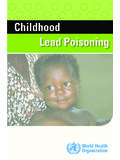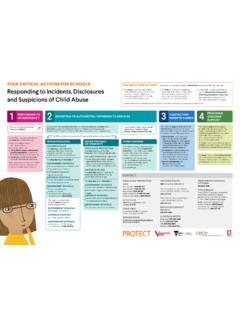Transcription of HCP Infographic Protect Your Patients from Sepsis
1 Protect YOUR Patients FROM Sepsis . Infections put your Patients at risk for Sepsis . Be alert to the signs and, when suspected, act is the body s extreme response to an infection. It is life-threatening, and without prompt treatment, often rapidly leads to tissue damage, organ failure, and STATS More than million people get Sepsis each year in the least250,000 Americans die from Sepsis each yearAbout1 in 3 patientswho die in a hospital have sepsisWHAT CAUSES Sepsis ? The most frequently identified pathogens that cause infections that can develop into Sepsis include Staphylococcus aureus (staph), Escherichia coli (E. coli), and some types of Streptococcus (strep).Four types of infections that are often linked with Sepsis :Lungs ( , pneumonia) Urinary tract ( , kidney)SkinGutAnyone can get an infection, and almost any infection can lead to Sepsis .
2 Some people are at higher risk of infection and Sepsis : WHO IS AT RISK?Adults 65 or olderPeople with chronic medical conditions, such as diabetes, lung disease, cancer, and kidney diseasePeople with weakened immune systemsChildren younger than oneWHAT ARE THE SIGNS OF Sepsis ? Signs of Sepsis can include any one or a combination of the following:Confusion or disorientationShortness of breathHigh heart rateFever, or shivering, or feeling very coldExtreme pain or discomfortClammy or sweaty skinSepsis is a medical emergency. Protect your Patients by acting fast. Your Patients risk of death increases with delayed recognition and treatment of Sepsis . HOW CAN I GET AHEAD OF Sepsis ?Healthcare professionals can: Know Sepsis signs to identify and treat Patients early. Act fast if you suspect Sepsis . Prevent infections by following infection control practices ( , hand hygiene, catheter removal) and ensuring Patients receive recommended vaccines.
3 Educate your Patients and their families about: - Preventing infections. - Keeping cuts clean and covered until healed. - Managing chronic conditions. - Recognizing early signs of worsening infection and Sepsis and seeking immediate care if signs are SHOULD I DO IF I SUSPECT Sepsis ?Know your facility s existing guidance for diagnosing and managing Sepsis . Immediately alert the clinician in charge if it is not you. Start antibiotics as soon as possible, in addition to other therapies appropriate for the patient. Check patient progress frequently. Reassess antibiotic therapy within 24-48 hours to stop or change therapy as needed. Be sure antibiotic type, dose, and duration are correct. Learn more about Sepsis and how to prevent infections.














